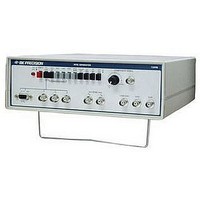1249B B&K Precision, 1249B Datasheet - Page 11

1249B
Manufacturer Part Number
1249B
Description
COLOR GENERATORNTSC/RGB
Manufacturer
B&K Precision
Type
NTSC Benchtopr
Specifications of 1249B
Patterns
Bar, Dot, Crosshatch, Raster
Connection Method
RCA, RF, S-Video
Power Source
105,130VAC
Signal Generator Type
NTSC Pattern
Supply Voltage Range
105V To 130V
External Height
86mm
External Width
290mm
External Depth
264mm
Frequency
30 Hz
Equipment Type
NTSC Pattern Generators
Lead Free Status / RoHS Status
na
Lead Free Status / RoHS Status
na
Other names
BK1249B
THE NTSC COLOR VIDEO SIGNAL
HISTORY
In 1953, the NTSC (National Television Systems
Committee) established the color television standards
now in use by the television broadcast industry in the
Fig. 1. Composite of Video Signal; One Horizontal
Line of NTSC Color Bars Signal
11
United States and many other countries. It was, of course,
compatible with the monochrome (black and white) system that
previously existed. The makeup of a composite video signal is
dictated by NTSC specifications. These specifications include a
525-line interlaced scan, operating at a horizontal scan frequency of
15.734.26Hz and a vertical scan frequency of 59.94Hz. A
3.579545MHz subcarrier contains the color information. The phase
angle of the subcarrier represents the hue: the amplitude of the
subcarrier represents saturation.
HORIZONTAL SYNC
(Refer to Fig. 1)
The "beginning" of a line horizontal scan occurs at the leading edge
of the horizontal blanking pedestal. In a television receiver, the
horizontal blanking pedestal starts as the electron beam of the CRT
reaches the extreme right-hand edge of the screen (plus a little
overscan in most cases). The horizontal blanking pedestal prevents
illumination of the screen during retrace, that is, until the electron
beam deflection circuits are reset to the left edge of the screen and
ready to start another line of video display. The entire horizontal
blanking pedestal is at the blanking level or the sync pulse level. In
a television receiver, the blanking and sync pulse levels are the
"blacker than black" levels that assure no illumination during
retrace.
The horizontal blanking pedestal consists of three discrete parts:
the front porch, the horizontal sync pulse, and the back porch. The
front porch is a 1.40 microsecond period at second










